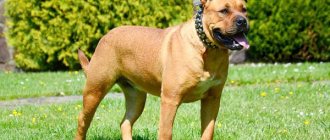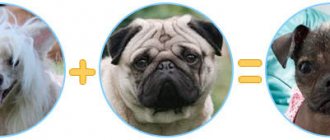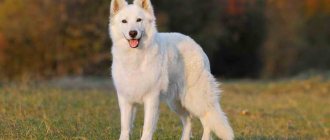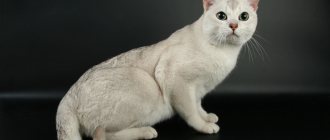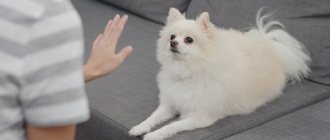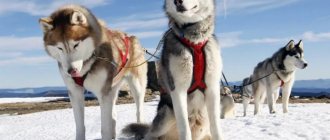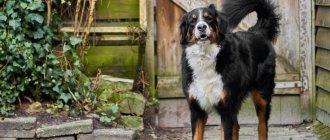Origin story and what it looks like in the photo
DNA studies of Shar Peis have shown that the age of this breed is about three thousand years.
There is also material evidence that folded dogs are one of the oldest breeds. Figurines of animals with a characteristic appearance date back to the 3rd-2nd century BC. One of the emperors of the Celestial Empire, for unknown reasons, ordered the destruction of all Shar Pei breeding books. Therefore, many details of the development of the breed have to be speculated and assumed. Accurate facts include the widespread prevalence of Shar Peis in their homeland, as well as their use as guard and hunting dogs.
The 20th century was a critical moment for the breed. With the rise of the Maoists - the Communist Party - to power, having pets in the house became a sign of luxury. After the end of the persecution of animals, World War II began, which led to hunger and poverty in China.
Historians and researchers call it a real miracle that several purebred representatives of the breed remained alive after all these events. The surviving dogs were mainly kept in rural communities on the island of Taiwan.
Most likely, the breed would have simply disappeared among the many yard dogs, but chance helped. In 1971, a purebred Shar Pei fell into the hands of a breeder from the USA. The American was very impressed by the unusual appearance of the puppy and the tragic history of the breed. He published an article in a specialized magazine for dog breeders. Under the photo of the baby there was a caption: “This may be the last Shar Pei in the world.”
Breeders and ordinary dog lovers have traveled all over China in search of purebred Shar-Peis. In the entire country, only eight dogs could be found in five years. These animals had an important mission: to become the basis for the restoration of the breed.
8 dogs is too few for normal development. Therefore, American breeders resorted to crossing Shar Peis with Chow Chows and other related breeds. This is how the American type of Shar-Pei turned out.
The standard and first pedigree of the American Shar Pei appeared only in 1976. By this time, representatives of the breed had already won the hearts of dog lovers in the USA and Europe.
In 1978, Shar Peis were included in the Guinness Book of Records as the rarest dog breed in the world. Prices for puppies reached several thousand dollars, and the waiting list was scheduled for several years in advance.
History of appearance
This breed was bred for dog fighting, a popular entertainment among the common people of Ancient China from the 3rd-2nd century BC. Features that helped dogs in fights developed and were cultivated: folds and short, spiky hair for protection, powerful jaws and paws for attack.
Over time, representatives of the breed spread widely throughout the territory of the Celestial Empire and mastered new functions for themselves - protecting property, protecting the owner and hunting large animals. Shar Peis were ideal for performing these tasks.
For some unknown reason, the breeding books of Chinese Shar-Peis were destroyed by order of one of the rulers of the Celestial Empire. Because of this, much of the breed's history is based on logical calculations and assumptions.
But the date when Chinese Shar-Peis could disappear completely is clearly defined - 1949. It was at this time that the communists, who came to power in China, decided that any pets were a legacy of the hated regime. Huge taxes were imposed on the maintenance of animals, and often the unfortunate four-legged friends were simply destroyed, without regard to thoroughbredness or historical value.
After a few years, Shar Peis remained only in remote rural farms, where the owners carefully hid them from the authorities.
In 1965, a Chinese Shar-Pei puppy, Lucky, arrived in the United States, and it was he who became the impetus for the emergence of American Shar-Peis, but that is a completely different story.
After the end of the terror declared on four-legged friends, war began in communist China. The fact that after its end the old-type Chinese Shar-Peis still existed can only be described as a miracle.
In 1976, the breed standard was approved, and 9 years later, Shar Peis were recognized by the American Kennel Club. In our country, dogs of this breed appeared only in the 1990s.
Description of pets
The appearance of Shar Peis cannot leave anyone indifferent. Powerful, stocky body, folds of different sizes on the head, body, legs, serious, “frowning” muzzle, plush short hair, small triangular ears that fit tightly to the head, blue-black pigmentation of the mouth and tongue, “pretzel” tail.
The American Shar Pei differs from its Chinese ancestors, who, despite all the incidents, remained in their homeland and are under the careful supervision of Asian breeders.
- The head of the American Shar Pei is longer than that of its Chinese relatives, the nose is not so voluminous, and the upper lip does not hang so much over the lower lip.
- The number of folds is smaller, they are located mainly on the head and neck.
- The American-type dogs themselves are larger, their paws are longer.
- American breeders have achieved the appearance of black and monochrome colors in Shar Peis.
As a result of crossing Chinese purebred dogs with Chow Chows, the American type of breed developed several types of coat.
- horse - hair length up to 1 centimeter - Chinese breeders recognize only this type of hair in purebred Shar-Peis;
- brush - hair up to 2.5 centimeters long - international associations recognize such dogs as purebred, despite the resistance of Asian experts;
- bear - hair longer than 2.5 centimeters - with such fur, Shar Peis are not allowed to show-class exhibitions, but it is precisely these pets that have found ardent fans all over the world.
All types of Shar-Pei have folds, but in dogs with teddy bears they are not visible under the fur.
Dimensions and weight
According to the standard, the height of Shar Peis varies from 44 to 51 centimeters, weight - from 18 to 35 kilograms.
Color variations
The current latest edition of the standard dates back to 2005. It has added color options that were previously considered not characteristic of purebred Shar-Peis: Isabella and Isabella delta, as well as lilac.
Shar-Pei colors are divided into basic and delute - without black pigment.
- The main ones are black, red, deer, cream, sable, blue, Isabella, lilac.
- Delutovye - chocolate delut, red delut, apricot delut, cream delut, isabella delut.
Various shades of color are allowed, except white. A purebred Shar Pei must be a solid color. A slight lightening of the main color on the tail and under it and darkening on the muzzle and back are allowed.
Description of the breed
The Chinese Shar Pei is a medium-sized dog with a strong, dense body and a head covered with deep folds.
Characteristics of the breed standard :
- the head is massive, square in shape, the skull is flat, the muzzle is wide;
- the nose is large, the nostrils are open, the lobes are pigmented black, but, depending on the color, brick and brown colors are allowed;
- the eyes are almond-shaped, because of the folds of skin covering them, the muzzle appears gloomy;
- the ears are small, triangular, set high, pressed to the skull;
- the gums, palate and tongue are blue-black or lavender, with individuals with isabella and blue coats having pink spots on the tongue;
- lips are slightly swollen and thick;
- scissor bite;
- the length of the body is almost equal to the height at the withers;
- the back is straight, wide;
- the topline is slightly sunken in the lumbar region;
- the stomach is tucked;
- the tail is thick, cone-shaped, curled into a ring, set high;
- The limbs are straight, with well-developed muscles, set parallel, the hind limbs are wider apart than the front limbs.
The coat can be of 3 types:
- horse (hairs no more than 1 cm long);
- brush (hairs 2.5 cm);
- bear (hairs 2.5-3.5 cm).
NOTE!
Bear-haired Shar Peis are not recognized as a show breed.
Character of Shar Peis
The appearance of this breed is deceiving. Looking at the always frowning, gloomy Shar Pei, you can consider him an evil guard. Taking a closer look at the remarkable folds and plush fur, the opinion changes to the opposite - the dog seems surprisingly sweet and good-natured. Both are mistakes.
Thousands of years spent as a fighter, dangerous game hunter, guard and watchman could not but affect the character of the Shar Pei. And the mixture with the Chow Chow in the American type of the breed added new features.
Shar Peis are distrustful of strangers. You can be sure that the oncoming Shar Pei carefully examined, assessed the degree of threat and prepared to stop any attempts to harm the owner or his property. Treats and kind words from strangers do not bother the dog.
Unfamiliar animals also cannot boast of a kind attitude on the part of the Shar Pei. This pet perceives dogs as competitors and rivals, and cats as legitimate prey. He will make an exception for those with whom he grew up.
But in the family circle, the folded representative of the breed is transformed. Attachment to the owner, expectation of attention and affection, restraint, readiness to protect and protect - this is the Shar Pei at home.
Representatives of the American type of the breed have a strong sense of self-esteem. Proud dogs will not beg for affection, jump enthusiastically and wag their tail when meeting their owner. Emotions are carefully hidden, but this does not mean that the pet does not experience them.
The “dark side” of Shar Peis is the desire for leadership. The owner will have to carefully build hierarchical relationships, proving to the dog who is boss in the house. From time to time you will have to fight off the attempts of the American Shar Pei to change roles with the owner.
In the family, everyone should evaluate the Shar Pei’s actions equally: one should not be allowed to scold and another to praise for the same action.
There will be no problems with older children if you teach them correct behavior. You cannot make sudden movements, do not cause pain to the animal, do not impose unfair punishments - nothing special, but Shar Peis are especially sensitive to violation of these things. With the right approach, a dog of this breed will communicate well with children. They will take part in games and walks, while simultaneously performing security functions.
But experts do not advise families with or planning to have small children to have a Shar Pei. Children can unknowingly hurt the dog and do not control their movements. American-type Shar Peis are not a breed that is ready to tolerate anything. In addition, these are massive dogs, which themselves, without meaning to, can push a child or miscalculate their strength when playing.
The dog will treat children who appear when the Shar Pei is already living in the family with misunderstanding and suspicion; it will take time for the pet to get used to the new addition to the family.
Sudden, unexpected movements are generally not recommended in the presence of a Shar Pei: this is due to the nature of the breed. The folds greatly reduce the dog's vision, and sudden, rapid movements can either frighten him or provoke aggression.
An important advantage of Shar Peis is their adaptability to apartment living. A calm disposition, low maintenance requirements and not too much need for physical activity are qualities that, on the contrary, do not contribute to a dog’s life on the street.
There is a misconception regarding the “fighting” type of these dogs - Shar Peis are accused of being aggressive. In fact, aggression was lacking in this dignified plush pet even in the distant past. To fully participate in dog fighting, Shar Pei were given herbal infusions that increased aggressiveness. And centuries of security service and the intervention of breeders have reduced the ability for aggression of representatives of the American type to almost zero.
The Shar Pei won’t vocalize again, but it will definitely warn you by barking or growling that there is someone behind the door - the security streak has not gone away.
Character traits
Representatives of this breed are alert, intelligent and responsible. While outwardly appearing to be gloomy, withdrawn and pessimistic dogs, Shar Peis are actually very friendly and affectionate. They are distrustful of strangers, but love to spend time with their owner and his family.
For these dogs, the owner is the most important thing in life. They adapt to his mood and lifestyle, enjoying spending time with him, be it active walks or a quiet evening at home.
Shar Peis are prone to dominance, so it is important from the very beginning to show them who is in charge and to stop all attempts to take the place of leader - sensing the weakness of the owners, the Shar Pei will imagine itself as the leader and will behave accordingly.
These dogs are able to recognize threats, which makes them good watchdogs, and their fighting background and fearlessness allow them to defend their owners without hesitation, even if the enemy surpasses them in size and strength.
Other animals are most often treated aggressively, with the only exception being pets that grew up with them in the same territory. They get along well with children, but only if they grew up together.
Expert opinion
Kozhevin Semyon Kirillovich
Expert dog handler.
Independence, calmness and devotion are the main traits inherent in Chinese Shar-Peis. Despite their rather modest characteristics, these are temperamental dogs, whose character is influenced by the goals of their breeding. Representatives of this breed behave independently, arrogantly and even aggressively with strangers, but with members of their family they are affectionate and friendly. Due to their tendency to dominate, Shar Peis need an owner with leadership qualities and a strong character.
Advantages and disadvantages
There is probably no ideal dog suitable for every person. American Shar-Peis also have negative and positive distinctive features, which you need to think carefully about before getting a dog of this breed.
Advantages
- A dog can and should be kept in an apartment.
- Pet cleanliness.
- An unobtrusive companion.
- Attractive appearance of the dog.
- Hassle-free care.
- No “dog” smell.
Flaws
- High likelihood of food allergies.
- Vulnerability to many diseases.
- The desire for dominance.
- Long walks are required.
- Parenting requires skill and experience.
- Problems are possible in relationships with young children.
Meet the Shar Pei. First impression
Some external features of the Shar Pei lead scientists to believe that the ancestors of the Chinese dog were Molossians (ancient mastiffs) and Chow Chows. From the Molosser the Shar Pei took strength, solidity, and a certain monumentality. It is similar to the Chow Chow due to its similar physique and blue tongue, which, according to legend, is a talisman that protects the dog’s owner from evil spirits.
The very name of the breed (sa-pei - “sand skin”) is interesting and speaks of another exotic feature of the breed. The adjective “sandy” in this case does not refer to the color of the animal, but to the structure of the coat, which feels like granular, prickly sand. On the back and sides the hair is straight, short, raised, like bristles, on the limbs it is smooth.
If the subject of discussion is the Chinese Shar Pei, the characteristics of the breed first begin with a description of the amazing folded skin. In puppies, loosely hanging skin creates abundant folds in the head and neck area and covers the entire body. As they grow older, folds may remain only on the neck, withers and head.
When you look at a Shar Pei, you get the feeling that a fur coat that doesn’t fit is put on a small dog. The presence of folds may presumably indicate that the loosely hanging skin was formed as a result of the breeding of significantly smaller individuals from dogs of impressive size. This statement is to some extent based on historical evidence of the large size of the Shar Pei’s ancestors, weighing up to 80 kg.
How to properly care
People who have never owned a Shar Pei speak with horror about caring for folds on the animal’s body. In fact, there is nothing complicated or unusual about caring for this breed.
Wool and bathing
Remembering the different types of coats of Shar-Peis, we can say with confidence that dogs with horse and brush types of coat will not cause any problems. They don't shed, they don't have undercoat, so the apartment will be clean. Shar Peis with a bear will require more attention - their undercoat is thick.
You don't need to brush your pet more than two or three times a week. For this procedure, you need to get a brush designed for short hair.
It is necessary to wash your dog at least once every 3-4 months. In this case, use exclusively hypoallergenic shampoos so as not to harm the skin. During water procedures, protect your ears from water.
It is recommended to dry it with a hairdryer, while thoroughly drying the space inside the folds.
Ears
Two to three times a week you need to clean your ears of wax accumulated in them using a tampon and lotion. It is advisable to pluck the hair growing on the inner surface of the ears for better air access and ventilation.
Claws
If a Shar Pei walks a lot and often, the claws wear down on their own. But not everyone has the opportunity to devote so much time to walking, so a nail clipper is necessary. With its help, you need to trim your dog's nails monthly, but carefully so as not to damage the blood vessels.
Teeth
Dogs need to have their teeth brushed, and Shar-Peis are no exception. Regular brushing with a special paste for dogs will protect your pet from the formation of plaque and tartar.
Eyes
Clean water or chamomile infusion is what the “American” needs every morning. Rubbing the eyes removes secretions and dirt. Lack of care leads to serious inflammation.
Walk
Long walks are highly recommended for this breed. The more time your pet spends outside, the calmer he will be at home. But you should not use extreme walking - overcoming obstacles and running against the clock - not for Shar Pei.
Direct sunlight can damage the skin of a Shar Pei with short hair, and heat stroke is also not just empty words. Dog handlers recommend walking dogs of this breed in the morning and evening.
Care, nutrition and maintenance of the breed
You can keep a Shar Pei both in a private house and in an apartment. Cleanliness of dogs allows the owner to put a minimum of effort into caring for the pet. The Shar Pei does not have the unpleasant odor that many pets have. This allows you to raise a baby even in a small apartment.
To keep a Shar Pei, you must follow a number of rules. The Shar Pei is a born guardian. For this reason, his sleeping place (kennel, lounger) must be open so that the dog has an overview of the surrounding area. Otherwise, the dog will refuse the house.
You should not place your dog's sleeping area in a draft. Despite its dense coat, even a large Shar Pei can easily catch a cold. The street house is equipped with heating. You need to walk your Shar Pei twice a day. The walk can be either on a leash or without it. The pet does not need physical activity. Once a month, the dog is walked in a special area, where it runs without a leash and communicates with other dogs.
Nails should be trimmed as they grow, but no more than 2 times a month. Using a special brush, you need to comb your pet's fur once a week. During shedding, this is done daily due to the fact that smooth-haired Shar-Peis leave their sharp hairs everywhere.
Particular attention should be paid to caring for the ears. The entry of water and dirt into the ears provokes various diseases. As a preventive measure, it is necessary to wipe the Shar Pei's ears once a week and wipe them with a cotton pad soaked in water.
Eyes should be wiped once a day with wet wipes to remove mucus accumulated in the corners after sleep. It is necessary to accustom a Shar Pei to bathing from the first months of life, since the dog is not naturally friendly with water. This procedure should not be carried out often, only when the wool becomes dirty.
Teeth are cleaned using special bones, which can be purchased at a pet store. It is necessary to regularly visit the veterinarian and get vaccinated.
You can feed your pet with ready-made premium and super-premium dry food. It is necessary to build a diet in accordance with the manufacturer’s recommendations, as well as consultation with a veterinarian.
With natural nutrition, it is necessary to formulate the pet’s diet in such a way that feeding takes place 2 times a day. For breakfast, eat foods containing a minimum of protein. These include: rice porridge, boiled vegetables and offal. The pet's dinner consists of foods with a lot of protein: meat and boiled vegetables.
It is prohibited to include the following foods in the Shar Pei diet :
- sweet;
- pork;
- milk;
- liquid food (soups);
- some cereals and cereals (wheat, millet, pearl barley);
- tubular bones;
- sausages;
- bread;
- chicken fillet, thigh, drumstick.
Once a week you can give your dog a couple of raw chicken eggs mixed with low-fat cottage cheese, kefir or yogurt, as well as boneless sea fish fillet, previously scalded or stewed.
Life expectancy and major diseases
American Shar-Peis do not live very long: 10-12 years is their limit under a normal lifestyle.
Complex genetics and inbreeding during the formation of the American Shar Pei type also affected the health problems inherent in the breed:
- congenital or adult-onset problems with vision and hearing;
- increased risk of knee dislocation;
- a number of joint diseases;
- numerous allergic reactions to food;
- malocclusion;
- propensity for cancer.
When choosing a puppy, be sure to pay attention to the medical records of both the baby and his parents in order to reduce the likelihood of hereditary diseases.
The mystery of the “Han dog”: the origin of the breed
The beginning of the existence of the breed goes back to ancient times, back to three thousand years. The name of the breed is of Chinese origin. This is no accident. Images on household items and figurines found during archaeological excavations eloquently indicate that the Shar Pei was already known during the reign of the Chinese Han Dynasty. The “Golden Age” of China’s economic and cultural development is the most important milestone in the life of the “Han dog”.
The exact place of its appearance is not documented. Researchers suggest that the Chinese Shar Pei can originate from both the south and north of China:
- South coast: Kwong Tung (Dag Let village) or Guangdong (Taili) provinces.
- Northern China, Tibet.
In ancient times, the Shar Pei was used as a universal dog that guarded the home, guarded livestock in the pasture, protected peasant farms from mongooses, and hunted in the mountains and on the plains.
Often, at the will of the owner, the Shar Pei became a fighting dog. Strong jaws firmly dug into the flesh of the opponent, small ears pressed tightly to the head did not allow the enemy to grab onto them, strong bones adequately withstood any shock, the abundance of folds, prickly fur and stubborn disposition gave an additional advantage in battle. Only one character trait prevented him from turning into an exclusively fighting dog - peacefulness. The good-natured Shar Pei, a Chinese fighting dog, striving for peace and harmony, did not become a real fighter. However, participation in dog fights opened the doors of nobles' houses, temples and even the imperial palace towards him. The Shar Pei became a luxury item, a source of income, a favorite of the nobility, gradually becoming inaccessible to ordinary people.
Nutritional Features
The first thing to remember when buying a Shar Pei puppy is his increased sensitivity to food, which causes numerous allergies.
New foods should be added to the diet one at a time and in small portions to monitor the reaction of the dog’s body.
Shar Peis quickly gain excess weight. The owner’s task is to control the portion size, meal schedule and the absence of feeding from the table. Like most dogs, Shar Pei cannot eat salted, smoked, or floury foods.
Dry food intended for this breed must be premium - containing the necessary microelements. In addition, hypoallergenicity is the main requirement when choosing food.
Shar Pei should not be given pork or chicken. The rest of the nutritional recommendations do not differ from the standard ones. Porridge, vegetables, fruits, cottage cheese, fish - all these products perfectly diversify the diet and provide the necessary substances.
How and what to feed?
Each owner decides for himself what to feed his pet - natural products or industrial food.
A natural diet is good because the owner independently chooses and controls the quality of the products, and all the nutrients and vitamins entering the dog’s body are better absorbed.
In addition, such a diet costs much less. However, creating a menu requires a lot of time and certain knowledge, since it is quite difficult to balance this type of food for a Shar Pei.
The menu should include:
- lean meat;
- offal;
- porridge;
- sea fish;
- low-fat fermented milk products;
- vegetables and fruits.
Shar-Peis should not be fed:
- milk;
- sweets;
- fatty meat;
- millet, wheat, pearl barley;
- sausages;
- bread;
- tubular bones.
CAREFULLY!
Soups and other liquid foods can cause indigestion and kidney problems.
Industrial feeds are convenient because their composition is already balanced and enriched with essential vitamins and minerals.
It is important to choose products of at least premium class, which do not contain animal fats, meat flour, by-products, dyes or flavors, and where protein comes first. Popular food brands are Orijen, Go, Acana.
Up to 3 months, Shar Peis should be fed 6 times a day, at 3-4 months - 5 times, at 4-7 months - 4 times, at 7-12 months - 3 times, adult dogs should be fed twice a day. The serving size of an adult Shar Pei should be 3.5% of its weight.
Training and education
To the square
Ke Shar-Peis learn commands well, but carry them out quite slowly. The qualities inherent in nature and many years of history contribute to the completion of the security course.
Socializing your puppy at a very young age will make life easier for the owner. The dog will not be afraid or show aggression in response to the noise of cars or the sight of other animals, and will learn norms of behavior.
The owner is obliged to prove to the pet that he is worthy of the title of leader. Moreover, you will have to put the dog in his place more than once - Shar-Peis themselves are not averse to becoming the boss, so they constantly test the owner “to the point of breaking.”
In all other respects, there will be no problems with upbringing. “Americans” clearly understand the rules and strictly follow them. They don’t interfere, they don’t impose.
Feeding
Consulting with the breeder is a rule that must be followed. For the Chinese Shar Pei breed, nutrition is one of the main factors affecting the health of the pet. Therefore, you should strictly follow the recommendations received when purchasing a puppy.
In the future, if there is a need to change the diet, it should be taken into account that you cannot mix natural food and dry food during the same feeding, since they are absorbed differently by the body.
Dry food must be of high quality, balanced to the needs of the breed. The pet must be provided with constant access to a bowl of clean water. Due to the structure of their muzzle, Shar Peis usually drink sloppily, spilling liquid. To maintain cleanliness, a bowl of water can be placed on an absorbent mat or cloth.
When choosing natural food, you should pay attention to the list of prohibited foods:
- pasta;
- legumes;
- pork;
- bird with tubular bones;
- products with salt and spices, including sausage and smoked meats;
- cheeses;
- milk.
Among those allowed:
- beef;
- buckwheat, rice;
- chicken;
- offal;
- lamb meat;
- sea fish;
- turkey;
- fresh greens.
Chinese Shar Pei puppies can receive encouragement and treats in the form of bread crumbs without additives, stringy bones, and tripe.
For the health of your Shar Pei, it is important not to change its diet unless necessary, as this can lead to allergies. No more than 22% protein is allowed in food (dry or natural).
An indicator of a balanced diet is active behavior, age-appropriate body weight, absence of odor, shiny eyes, shiny coat.
The owner's pride and joy is a healthy, active, full of energy Chinese Shar Pei. A photo of an adult dog is shown below.
How to choose
Choosing a reputable kennel is the most important thing when purchasing an American Shar Pei puppy. In all other cases, there is a high risk of adopting a non-purebred, sickly puppy.
What you should pay attention to when choosing:
- muzzle – wide;
- skull – rounded;
- ears are small and triangular;
- bite – scissor bite;
- the wool is shiny, there is no dandruff or bald spots on it;
- no tears flow, no smell from the ears;
- There are no pimples or irritations on the skin.
The baby should be active, curious, playful, have an excellent appetite, but without excessive aggression.
Chinese Shar Pei: description of the breed and international standard
In ancient references to the Sa-Pei, which have reached our time, the exotic breed is described figuratively:
- the head is like a pear, the ear is like a thick and small sea mollusk;
- the wrinkled muzzle resembles the face of an old man;
- the wide and blunt nose resembles the shape of a moth, and the eyes are sad almonds;
- the strong neck has a small dewlap, like the withers of a buffalo;
- the powerful chest is emphasized by widely spaced front legs, like those of a dragon;
- the hard and thick metacarpus resembles a head of garlic, and the claws resemble pincers;
- the back is flexible and elastic, like a shrimp;
- the tail looks like a hard and thin wire, twisted high above the back.
As a result of selection, the genetic pool of the Shar Pei is mixed with the blood of a chow chow, bulldog, boxer, and bull terrier. This made it possible not only to preserve the historically established characteristics of the exotic dog, but also to obtain the unusual color of the originally red Sa-Pei. Chocolate, black, cream and even blue coat colors add a special charm to this amazing dog and are no longer rare.
The Chinese Shar Pei was characterized according to the modern official standard in accordance with the features of the ancient dog:
- Average height and strong, square build.
- The lower back is strong.
- The chest is wide and dropped down.
- The neck is not long.
- Folds on the head and withers.
- The head is large.
- The ears are small, thick, rounded, fitting tightly to the skull.
- The muzzle is wide along its entire length, full, like a hippopotamus.
- The eyes are dark, deep-set, reminiscent of almonds; the expression of the eyes is gloomy.
- The tail is curled in a ring.
- A strongly built dog is compact and active.
- Classification: Molossian group.
- The purpose of the dog in accordance with the classification: hunting and guard.
Price range
- An American Shar-Pei puppy can be purchased second-hand, without a guarantee or documents. Such a purchase will cost no more than 10 thousand. The risks are obvious.
- Babies with deviations from the breed standard that do not allow participation in exhibitions will cost about 15 thousand.
- Puppies that meet all the requirements, with documents, will cost in the range from 25 to 30 thousand.
- Young “Americans” from distinguished parents who have a chance to become champions will be forced to fork out over 50 thousand.

